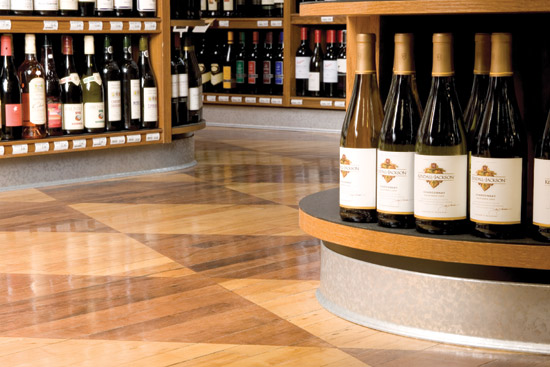New Sustainable and Aesthetic Options in Finishing Borders (Wall Base)
Considering Sustainability
Beyond building codes and budgets, the overall sustainability of a product is another consideration that more and more designers are becoming inclined to make before specifying any material. Evaluating the sustainable nature of a product requires a review of not only its material contents, but also its manufacturing processes and whether the product is ultimately reused or recycled.
Identifying the criteria that will be used to evaluate the sustainability of a product lays the foundation for being able to compare the sustainability of one product with another. These criteria can vary from designer to designer and, even, from project to project within a designer’s portfolio, depending upon the type of project, project objectives, and unique client preferences. In this article, the sustainable nature of various wall base solutions will be evaluated on the basis of the type of material used for the wall base, the environmental impact of the manufacturing processes employed to create the wall base, and whether or not it is possible to reuse or recycle the product.
Selecting More Sustainable Materials
The term sustainable material refers to a material that is generated from a resource that is managed in a way or replenished with a frequency, where it is considered, for all practical purposes, to be available into and beyond the foreseeable future. On the continuum between rapidly renewable resources and non-renewable resources, the more readily renewable the resource, the more sustainable the material is considered to be. A rapidly renewable resource is defined as being plant-based and having a harvest cycle of 10 years or less. Examples of rapidly renewable resources include bamboo, agrifiber, cotton, and natural rubber, a material used in certain types of resilient wall base.
 |
Certain types of resilient wall base are made from natural rubber, a rapidly renewable resource. Photo courtesy of Tarkett |
Products containing recycled materials can also offer a more sustainable product solution. Specifying products that contain recycled materials actively diverts materials from the waste stream, and the landfill, for recycling and reuse. Resilient wall base that contains some level of recycled content is also now available on the market.
Comparing the Materials in TV, TP, TS Wall Base
As previously mentioned, TV, TP and TS are three different types of resilient wall base manufactured from three different material blends. These various material blends can have different sustainable properties. For example, TV wall base can contain recycled content, while TS wall base can contain different amounts of natural rubber, a rapidly renewable resource.
Selecting Non-Toxic Materials
A material can continue to impact an environment, even after it is removed from the ground. Some materials release a gas into the interior environment, after they have been processed and installed, a phenomenon called off-gassing. Look for wall bases that have low volatile organic compound (VOC) emissions and meet the requirements of CA01350 to ensure good indoor air quality, which affects the wellbeing and health of people in spaces.
Phthalates and polyvinyl chloride (PVC) are often used in manufacturing resilient wall base to improve the flexibility and durability of the product. Some manufacturers have changed their plasticizers for phthalate alternatives making them safe solutions to use in interior spaces. Concerns have been raised about the impact that phthalates can have on the air quality of the interior environment and the health of building occupants. It is important for the specifier to use low emitting wall base and consider products that are made with alternative types of plasticizers.
There is a new pilot credit in LEED 2009 that promotes chemicals of concern avoidance. This new pilot credit, entitled Avoidance of Chemicals of Concern, is pilot credit 54 in the Materials and Resources category (MRpc54) and it was written with the intent of “reducing the concentration of chemical contaminants that can damage air quality, human health, productivity, and the environment.” This pilot credit was closed to new registrations on February 15, 2013. Projects that registered for the credit prior to February 15, 2013 can continue to pursue it.
It should be noted that there is some controversy that surrounds the opinion that the presence of phthalates and PVC reduces the overall sustainability of a product. While one side points to the adverse health effects that these products may contribute, others cite the increased longevity that the use of PVC and phthalates can provide, which dramatically reduces the total amount of product that will be placed in a landfill every year. All PVCs are not made equal; some made with phthalate alternatives and low emissions are sustainable products to use in interiors. Specifiers will need to consider the unique needs and objectives of each individual project to identify whether the presence or absence of phthalates or PVC is in its best interest.
Phthalates and PVC in TV, TP, and TS
Depending upon the needs of the project, there is a resilient wall base that will offer a specifier the right presence of phthalates and PVC. TV contains PVC and is available in products that do and do not contain phthalates. Wall base made from TP may or may not contain PVC and may or may not contain phthalates. Wall base made from TS is both phthalate-free and PVC-free.
Efficient Manufacturing Processes
The efficiency of a manufacturing process relates to both the energy consumed for the manufacturing process and the waste created during the process. More efficient processes consume less energy and create less waste.
The Differences in Manufacturing TV, TP, TS
Wall base made from thermoplastic materials, which include both TV and TP wall base, are manufactured by heating the thermoplastic material until it melts and then shaping it and cooling it to give it its desired shape. Thermoset products, like TS wall base, undergo a chemical process that changes the molecular structure of the material and cures it into its shape.
When comparing the energy consumption of the two processes, it takes more energy to heat a material enough to change it at a molecular level than it does to simply change its shape. So it follows that it takes more energy to manufacture a wall base made from TS than one made from a thermoplastic blend like TV or TP.
There are certain aspects of the wall base production process that directly affect the amount of waste that can be produced. The use of dye lots in a product is one such aspect. If dye lots are not used during production, the amount of waste and scrap material produced is reduced throughout the supply chain.









